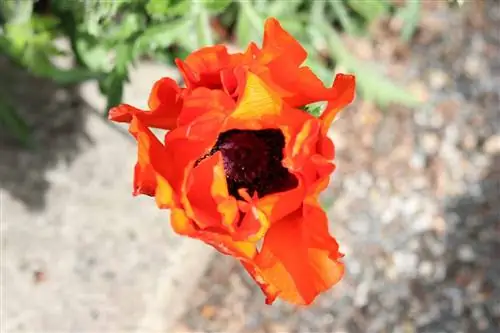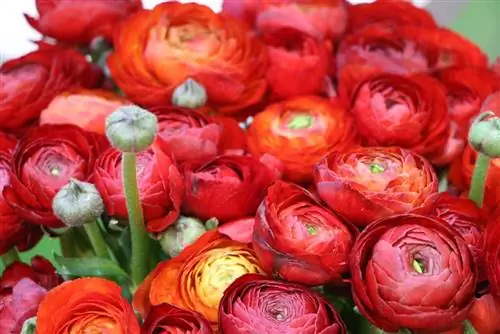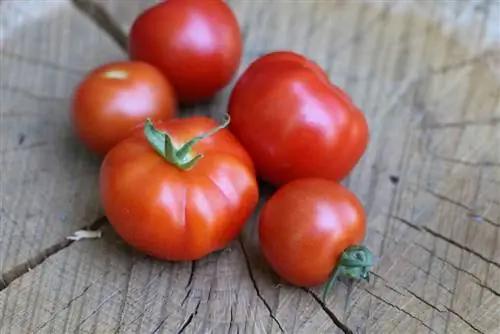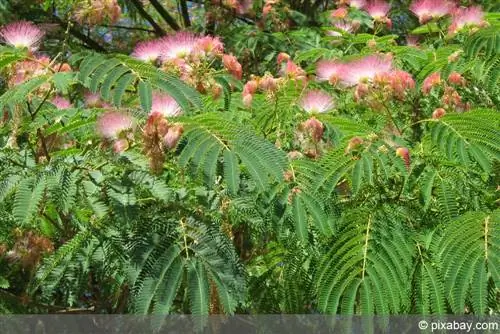- Author admin [email protected].
- Public 2023-12-17 03:39.
- Last modified 2025-01-24 12:45.
If the term oriental poppy seems rather unfamiliar at first glance, you will certainly know this plant species under the more common name fire poppy. A special feature of this plant, which belongs to the poppy family, is undoubtedly its magnificent bowl-shaped flower. In its orange-red to deep red foliage, it actually appears extremely oriental and at the same time symbolizes the enormous power and luxuriance of nature.
The poppy flowers, which are up to fifteen centimeters wide in diameter, appear much more robust than the delicate petals of the light red poppy, not only because of their size. The Oriental poppy originally comes from Iran and large parts of Turkey, but the plant is also native to the Caucasus or Iran.
The plant has also reached Germany via numerous routes over the past three hundred years. Through further breeding, the oriental poppy has now become a very popular ornamental plant for the garden.
Many interesting-looking varieties are available commercially, including multicolored, double or fringed ones, which are guaranteed to attract attention from visitors and curious neighbors.
Seeds and sowing
The Oriental poppy blooms in May and June. The plants can be pollinated by insects, but also by self-pollination of the hermaphrodite flowers.
The seeds of the plant are ripe around August. These look kidney-shaped and have a net-like structure. Inside they contain an oily nutrient tissue. The pore capsule that the poppy plant forms is about three centimeters long and grows upright, club-shaped from the center of the flower.
Below the stigma, the capsule fruit opens and releases its seeds through numerous holes. The wind throws them out and spreads the seeds over long distances. In addition to self-sowing and spreading through runners, the oriental poppy can also be propagated after flowering by dividing larger perennials.
The seeds, which are usually found in large numbers in the capsules, can also be removed specifically and re-sown in desired places. Reproduction via root cuttings taken in winter is also possible.
What care does oriental poppy need?
The Oriental poppy is very long-lasting and uncomplicated - provided it gets the right location for the plant. This must definitely be warm and sunny. The oriental poppy therefore thrives particularly well in southern exposure.
The plant is naturally quite strong, so it grows in fresh, well-drained soil even without any extra nutrients. The oriental poppy will still respond gratefully to an occasional compost addition in autumn or spring.
For the he alth of the plant and its deep-growing taproots, the soil must not be too wet, because the poppy cannot tolerate waterlogging.
A little distance can't hurt
A heavy but nutrient-rich clay soil can be loosened with sand to make it suitable for planting poppies. The space required by the plant is another important criterion when choosing a location.
The main thing that needs to be taken into account here is that the plants can reach considerable size in the first year and tend to overgrow smaller plants. For this reason, it is advisable to maintain a planting distance of at least 50 to a maximum of 80 centimeters.
Once you have decided on the location of your oriental poppy, it should no longer be transplanted because of its strong roots. The poppy leaves dry out in the summer, but sprout again in the fall. As a result, the plant overwinteres green.
Easy to care for and visually very appealing
The easy-care perennial plant is frost hardy and does not require any special winter protection. It also usually survives dry phases without any problems. Well-suited neighboring plants for the oriental poppy include English roses, delphiniums or goldenrod.






